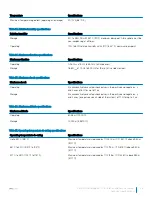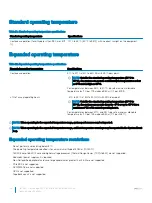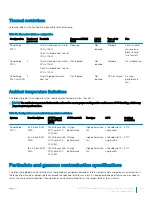
Option
Description
However, if power saving considerations outweigh performance, you might want to reduce the frequency of the
CPU communication links. If you do this, you should localize memory and I/O accesses to the nearest NUMA node
to minimize the impact to system performance.
Virtualization
Technology
Enables or disables the virtualization technology for the processor. This option is set to
Enabled
by default.
Adjacent Cache
Line Prefetch
Optimizes the system for applications that need high utilization of sequential memory access. This option is set to
Enabled
by default. You can disable this option for applications that need high utilization of random memory
access.
Hardware
Prefetcher
Enables or disables the hardware prefetcher. This option is set to
Enabled
by default.
DCU Streamer
Prefetcher
Enables or disables the Data Cache Unit (DCU) streamer prefetcher. This option is set to
Enabled
by default.
DCU IP Prefetcher
Enables or disables the Data Cache Unit (DCU) IP prefetcher. This option is set to
Enabled
by default.
Sub NUMA Cluster
Enables or disables the Sub NUMA Cluster. This option is set to
Disabled
by default.
Logical Processor
Idling
Enables you to improve the energy efficiency of a system. It uses the operating system core parking algorithm and
parks some of the logical processors in the system which in turn allows the corresponding processor cores to
transition into a lower power idle state. This option can only be enabled if the operating system supports it. It is set
to
Disabled
by default.
X2APIC Mode
Enables or disables the X2APIC mode. This option is set to
Disabled
by default.
Dell Controlled
Turbo
Controls the turbo engagement. Enable this option only when
System Profile
is set to
Disabled
.
NOTE:
Depending on the number of installed CPUs, there might be up to four processor listings.
Number of Cores
per Processor
Controls the number of enabled cores in each processor. This option is set to
All
by default.
Processor Core
Speed
Specifies the maximum core frequency of the processor.
Processor n
NOTE:
Depending on the number of CPUs, there might be up to four processors listed.
The following settings are displayed for each processor installed in the system:
Option
Description
Family-Model-
Stepping
Specifies the family, model, and stepping of the processor as defined by Intel.
Brand
Specifies the brand name.
Level 2 Cache
Specifies the total L2 cache.
Level 3 Cache
Specifies the total L3 cache.
Number of Cores
Specifies the number of cores per processor.
SATA Settings
You can use the
SATA Settings
screen to view the SATA settings of SATA devices and enable SATA and PCIe NVMe RAID mode on your
system.
Dell EMC PowerEdge R740 Installation and Service Manual
Pre-operating system management applications
47
















































